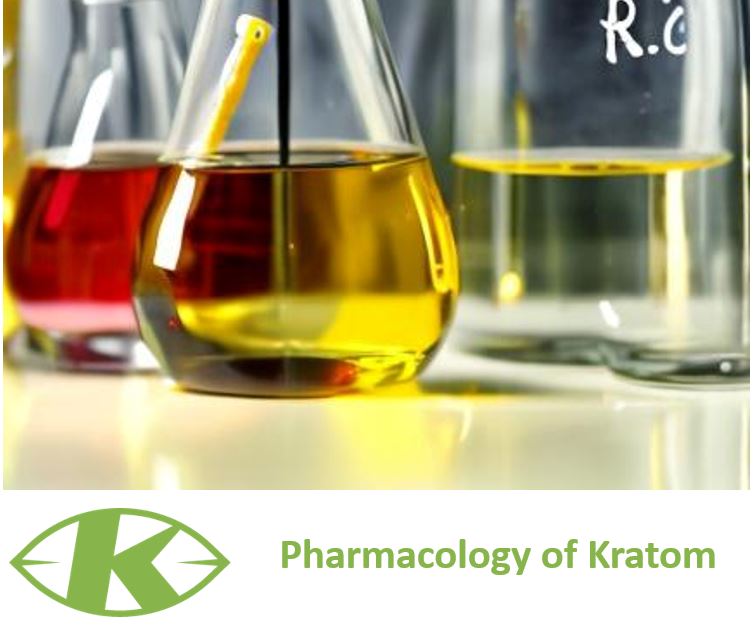
Pharmacology of kratom
Th Pharmacology of kratom includes 54 different alkaloids. These comprise speciociliatine, paynantheine, corynantheidine, mitragynine, 7-hydroxymitragynine (7-HMG), mitraphylline, rhynchophylline, mitralactonal, raubasine, and mitragynaline. Many of the complex effects of kratom are attributed to the alkaloids mitragynine and 7-hydroxymitragynine, however other alkaloids may also work in concert with one another.
With minimal affinity for the κ-opioid receptor, mitragynine and 7-HMG function as competitive antagonists of the δ-opioid receptor and partial agonists of the μ-opioid receptor. Compared to mitragynine, 7-HMG seems to have a greater affinity for the μ-opioid receptor. These substances exhibit functional selectivity and do not trigger the β-arrestin pathway, which is somewhat accountable for the drowsiness, constipation, and respiratory depression linked to conventional opioids. The blood-brain barrier is easily crossed by both mitragynine and 7-HMG.
Additionally, it appears that mitragynine inhibits COX-2, blocks L-type and T-type calcium channels, and interacts with various brain receptors such as A2A adenosine receptors, D2 dopamine receptors, and 5-HT2C and 5-HT7 serotonin receptors. Mitragynine inhibits the production of norepinephrine (noradrenaline) by stimulating α2-adrenergic receptors. Other chemicals in this class include clonidine, which is used to treat anxiety and some symptoms of opiate withdrawal, and dexmedetomidine, which is used for sedation. This may help to understand why using kratom along with other sedatives can be risky. Additionally, rhynchophylline, a non-competitive NMDA receptor antagonist, is present in Kratom.
Humans metabolize mitragynine using phase I and phase II processes, excreting the metabolites in urine. Kraton extracts inhibited CYP3A4, CYP2D6, and CYP1A2 enzymes in in vitro tests, suggesting a considerable possibility for medication interactions.
What is the pharmacology of kratom?
The pharmacology of kratom, a tropical tree native to Southeast Asia, is complex and multifaceted. The pharmacological properties of kratom primarily arise from its various alkaloids, the most prominent being mitragynine and 7-hydroxymitragynine. These compounds interact with opioid receptors in the brain, leading to kratom's noted effects such as pain relief, sedation, and euphoria. The pharmacology of kratom also involves interactions with other receptor systems, but its affinity for opioid receptors is most significant. This aspect of kratom's pharmacology has sparked interest in its potential as an alternative to traditional opioids, though concerns about its safety and abuse potential remain.
How does kratom's pharmacodynamics work?
Kratom's pharmacodynamics involves its active compounds, mainly mitragynine and 7-hydroxymitragynine, binding to opioid receptors in the brain. This binding primarily occurs at the mu-opioid receptors, which are crucial for mediating the pain-relieving effects. Kratom's pharmacodynamics also includes interactions with other neurotransmitter systems, including dopamine, serotonin, and norepinephrine pathways, contributing to its complex pharmacological profile. Understanding kratom's pharmacodynamics is key to exploring its potential therapeutic uses and managing its abuse potential.
What are the pharmacokinetics of kratom?
The pharmacokinetics of kratom, crucial in understanding its effects, involves absorption, distribution, metabolism, and excretion of its alkaloids, especially mitragynine and 7-hydroxymitragynine. Once ingested, kratom's alkaloids are rapidly absorbed, with mitragynine showing a higher bioavailability. Distribution of these alkaloids throughout the body varies, influencing kratom's pharmacological effects. Metabolism primarily occurs in the liver, leading to various metabolites that may contribute to kratom's effects. The elimination of kratom and its metabolites is predominantly via renal excretion. The pharmacokinetics of kratom varies among individuals, influencing its pharmacological effects and potential risks.
What are the specific pharmacological effects of kratom?
Kratom's specific pharmacological effects are diverse, largely due to its complex array of alkaloids. These effects include analgesia, stemming from opioid receptor activation, making kratom a potential alternative for pain management. Kratom also exhibits stimulant-like effects at lower doses, including increased energy and alertness. At higher doses, kratom's pharmacology leans towards sedative effects, characterized by euphoria and relaxation. Additionally, kratom's pharmacological effects on mood and anxiety have been noted, though research in these areas is still developing.
What does the pharmacological profile of kratom look like?
The pharmacological profile of kratom is characterized by a dual nature, offering both stimulant and sedative effects. This unique profile is a result of kratom's interaction with various neurotransmitter systems, including opioid, serotonergic, and adrenergic pathways. The predominant pharmacological effects are mediated by the alkaloids mitragynine and 7-hydroxymitragynine. The pharmacological profile of kratom also suggests potential therapeutic uses in pain management, opioid withdrawal, and mood disorders, though more research is needed to fully understand its benefits and risks.
What does current research say about kratom's pharmacology?
Current research on kratom's pharmacology reveals a growing interest in its potential therapeutic applications, particularly in pain management and opioid addiction treatment. Studies focus on the pharmacological effects of mitragynine and 7-hydroxymitragynine, exploring their interaction with opioid and other neurotransmitter systems. However, current research also highlights concerns regarding kratom's safety, abuse potential, and regulatory status. Ongoing studies aim to balance understanding kratom's pharmacological benefits with mitigating its risks.
How does kratom exert its mechanism of action?
Kratom's mechanism of action primarily involves its alkaloids, particularly mitragynine and 7-hydroxymitragynine, interacting with opioid receptors in the brain. This interaction, particularly with mu-opioid receptors, is central to kratom's analgesic effects. Kratom also affects other neurotransmitter systems, including serotonergic, adrenergic, and dopaminergic
To better understand potential downsides, check out Kratom Side Effects. Curious about the plant’s background? Learn more in Origins of Kratom.
Ready to experience its benefits? Try our Energy Kratom Caps or go with the trusted favorite—Try OG Caps.
Sources
Eastlack, S. C., Cornett, E. M., & Kaye, A. D. (2020). Kratom—Pharmacology, Clinical Implications, and Outlook: A Comprehensive Review. Pain and Therapy. Available at: https://www.ncbi.nlm.nih.gov/pmc/articles/PMC7203303/
Hanapi, N. A., et al. (2022). Editorial: The Pharmacology of Kratom and Its Alkaloids. Frontiers in Pharmacology. Available at: https://www.frontiersin.org/articles/10.3389/fphar.2022.878376
Prozialeck, W. C., et al. (2012). Pharmacology of Kratom: An Emerging Botanical Agent. The Journal of the American Osteopathic Association. Available at: https://www.degruyter.com/document/doi/10.7556/jaoa.2012.112.12.792/html
White, C. M. (2018). Pharmacologic and clinical assessment of kratom. American Journal of Health-System Pharmacy. Available at: https://academic.oup.com/ajhp/article-abstract/75/5/261/5102317?login=false
Tanna, R. S., et al. (2022). Translating Kratom-Drug Interactions: From Bedside to Bench and Back. Available at: https://www.ncbi.nlm.nih.gov/pmc/articles/PMC10353077/

